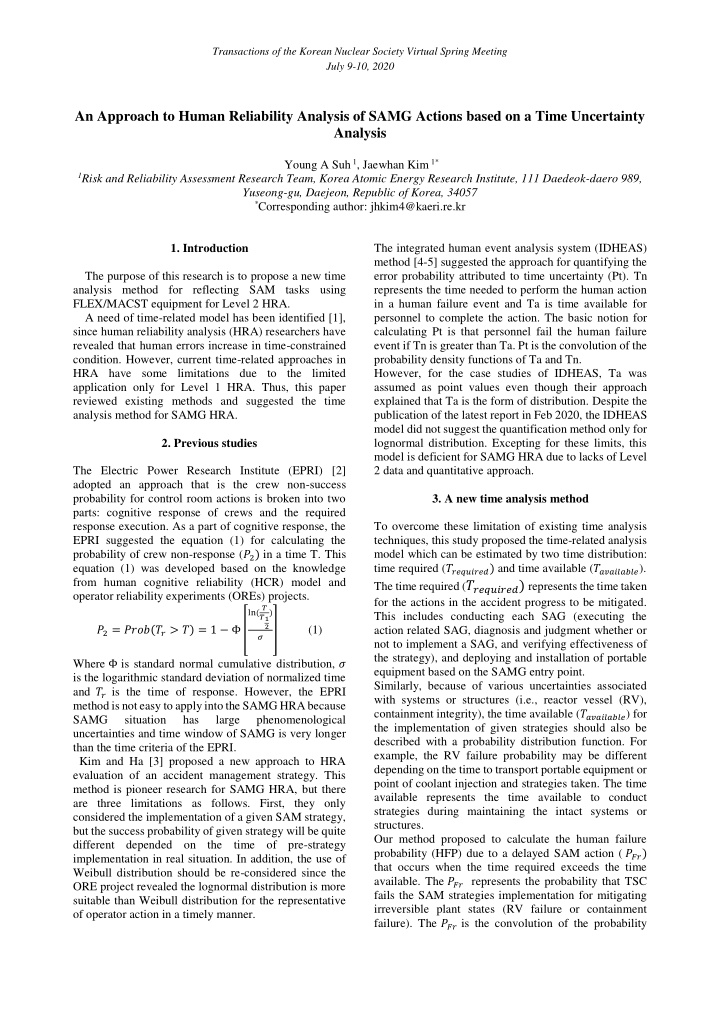



Transactions of the Korean Nuclear Society Virtual Spring Meeting July 9-10, 2020 An Approach to Human Reliability Analysis of SAMG Actions based on a Time Uncertainty Analysis Young A Suh 1 , Jaewhan Kim 1* 1 Risk and Reliability Assessment Research Team, Korea Atomic Energy Research Institute, 111 Daedeok-daero 989, Yuseong-gu, Daejeon, Republic of Korea, 34057 * Corresponding author: jhkim4@kaeri.re.kr 1. Introduction The integrated human event analysis system (IDHEAS) method [4-5] suggested the approach for quantifying the The purpose of this research is to propose a new time error probability attributed to time uncertainty (Pt). Tn analysis method for reflecting SAM tasks using represents the time needed to perform the human action FLEX/MACST equipment for Level 2 HRA. in a human failure event and Ta is time available for A need of time-related model has been identified [1], personnel to complete the action. The basic notion for since human reliability analysis (HRA) researchers have calculating Pt is that personnel fail the human failure revealed that human errors increase in time-constrained event if Tn is greater than Ta. Pt is the convolution of the condition. However, current time-related approaches in probability density functions of Ta and Tn. HRA have some limitations due to the limited However, for the case studies of IDHEAS, Ta was application only for Level 1 HRA. Thus, this paper assumed as point values even though their approach reviewed existing methods and suggested the time explained that Ta is the form of distribution. Despite the analysis method for SAMG HRA. publication of the latest report in Feb 2020, the IDHEAS model did not suggest the quantification method only for 2. Previous studies lognormal distribution. Excepting for these limits, this model is deficient for SAMG HRA due to lacks of Level The Electric Power Research Institute (EPRI) [2] 2 data and quantitative approach. adopted an approach that is the crew non-success probability for control room actions is broken into two 3. A new time analysis method parts: cognitive response of crews and the required response execution. As a part of cognitive response, the To overcome these limitation of existing time analysis EPRI suggested the equation (1) for calculating the techniques, this study proposed the time-related analysis probability of crew non-response ( 𝑄 2 ) in a time T. This model which can be estimated by two time distribution: time required ( 𝑈 𝑠𝑓𝑟𝑣𝑗𝑠𝑓𝑒 ) and time available ( 𝑈 equation (1) was developed based on the knowledge 𝑏𝑤𝑏𝑗𝑚𝑏𝑐𝑚𝑓 ). from human cognitive reliability (HCR) model and The time required ( 𝑈 𝑠𝑓𝑟𝑣𝑗𝑠𝑓𝑒 ) represents the time taken operator reliability experiments (OREs) projects. for the actions in the accident progress to be mitigated. ( 𝑈 ln ) This includes conducting each SAG (executing the 𝑈1 2 = 𝑄𝑠𝑝𝑐(𝑈 𝑠 > 𝑈) = 1 − Φ [ 2 𝑄 ] (1) action related SAG, diagnosis and judgment whether or 𝜏 not to implement a SAG, and verifying effectiveness of the strategy), and deploying and installation of portable Where Φ is standard normal cumulative distribution, 𝜏 equipment based on the SAMG entry point. is the logarithmic standard deviation of normalized time Similarly, because of various uncertainties associated and 𝑈 𝑠 is the time of response. However, the EPRI with systems or structures (i.e., reactor vessel (RV), method is not easy to apply into the SAMG HRA because containment integrity), the time available ( 𝑈 𝑏𝑤𝑏𝑗𝑚𝑏𝑐𝑚𝑓 ) for SAMG situation has large phenomenological the implementation of given strategies should also be uncertainties and time window of SAMG is very longer described with a probability distribution function. For than the time criteria of the EPRI. example, the RV failure probability may be different Kim and Ha [3] proposed a new approach to HRA depending on the time to transport portable equipment or evaluation of an accident management strategy. This point of coolant injection and strategies taken. The time method is pioneer research for SAMG HRA, but there available represents the time available to conduct are three limitations as follows. First, they only strategies during maintaining the intact systems or considered the implementation of a given SAM strategy, structures. but the success probability of given strategy will be quite Our method proposed to calculate the human failure different depended on the time of pre-strategy probability (HFP) due to a delayed SAM action ( 𝑄 𝐺𝑠 ) implementation in real situation. In addition, the use of that occurs when the time required exceeds the time Weibull distribution should be re-considered since the available. The 𝑄 𝐺𝑠 represents the probability that TSC ORE project revealed the lognormal distribution is more fails the SAM strategies implementation for mitigating suitable than Weibull distribution for the representative irreversible plant states (RV failure or containment of operator action in a timely manner. failure). The 𝑄 𝐺𝑠 is the convolution of the probability
Recommend
More recommend